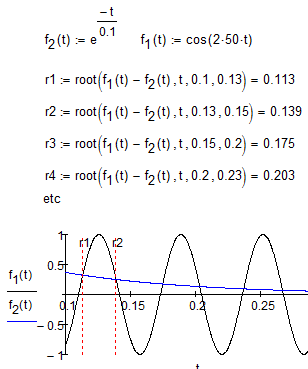Community Tip - Have a PTC product question you need answered fast? Chances are someone has asked it before. Learn about the community search. X
- Subscribe to RSS Feed
- Mark Topic as New
- Mark Topic as Read
- Float this Topic for Current User
- Bookmark
- Subscribe
- Mute
- Printer Friendly Page
How to solve an equation with multiple solutions?
- Mark as New
- Bookmark
- Subscribe
- Mute
- Subscribe to RSS Feed
- Permalink
- Notify Moderator
How to solve an equation with multiple solutions?
I've a problem to solve such equations, one unknown variable, but infinite solutions, it seems mathcad only return the first one, anyone can confirm this ? And how to handle these equations in MatchCAD?
Thanks.
Solved! Go to Solution.
- Labels:
-
Other
Accepted Solutions
- Mark as New
- Bookmark
- Subscribe
- Mute
- Subscribe to RSS Feed
- Permalink
- Notify Moderator
to find the first 5 - 10 roots first, you just have to search for the root within certain interval of x, change this interval and u find a new root. you pretty much almost have 1 solution for every half a period and less. look up root function in the mathcad help file. You can set the interval for which you are searching the solution.
and when t is large enough, the exponential function approach 0. thats why valery said the solution is just cos = 0 after couples of solution.
- Mark as New
- Bookmark
- Subscribe
- Mute
- Subscribe to RSS Feed
- Permalink
- Notify Moderator
I think you can use a numerical math for first 5-10 roots and than cos(t)=0
- Mark as New
- Bookmark
- Subscribe
- Mute
- Subscribe to RSS Feed
- Permalink
- Notify Moderator
Any details? I'm new to MathCAD, can you give me one example? 5~10 roots are enough for me, thanks.
- Mark as New
- Bookmark
- Subscribe
- Mute
- Subscribe to RSS Feed
- Permalink
- Notify Moderator
to find the first 5 - 10 roots first, you just have to search for the root within certain interval of x, change this interval and u find a new root. you pretty much almost have 1 solution for every half a period and less. look up root function in the mathcad help file. You can set the interval for which you are searching the solution.
and when t is large enough, the exponential function approach 0. thats why valery said the solution is just cos = 0 after couples of solution.
- Mark as New
- Bookmark
- Subscribe
- Mute
- Subscribe to RSS Feed
- Permalink
- Notify Moderator
Thanks, the problem solved. ![]()
- Mark as New
- Bookmark
- Subscribe
- Mute
- Subscribe to RSS Feed
- Permalink
- Notify Moderator
You welcome:

- Mark as New
- Bookmark
- Subscribe
- Mute
- Subscribe to RSS Feed
- Permalink
- Notify Moderator
The root function takes the form root(f(var), var, [a, b]). It returns the value of
var to make the function f equal to zero. The real numbers a and b are optional.
If they are specified (bracketed), root finds var on this interval. The values of a
and b must meet these requirements: a < b and f(a) and f(b) must be of opposite
signs.
It seems i must plot the two curves, then manually set the interval, or it won't give correct answer. Right ?
- Mark as New
- Bookmark
- Subscribe
- Mute
- Subscribe to RSS Feed
- Permalink
- Notify Moderator
Hua Zhang wrote:
It seems i must plot the two curves, then manually set the interval, or it won't give correct answer. Right ?
Not necessarily. Attached is a way of finding lots of roots in one go - at least for your given functions.
Alan


